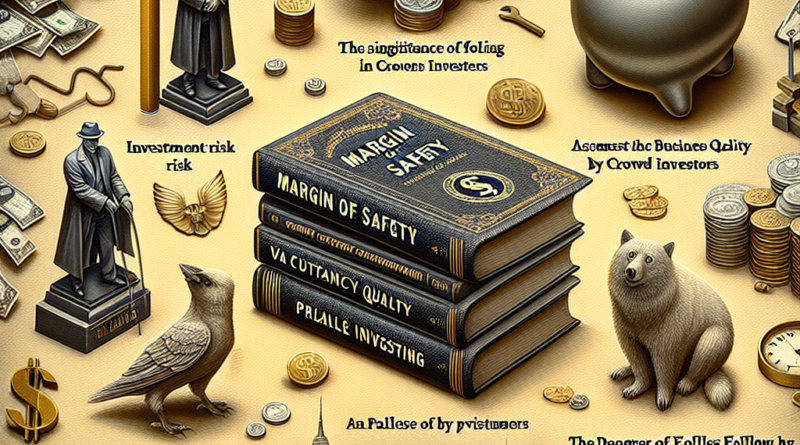Six Essential Lessons from Seth Klarman’s “Margin of Safety”: The Most Exclusive Book in Finance
“`html
Understanding “Margin of Safety” by Seth Klarman
“Margin of Safety,” penned by esteemed investor Seth Klarman, is regarded as one of the most influential texts in the world of investing.
Released in 1991, this book has become a rare collector’s item, with used copies fetching prices exceeding $2,000.
Its scarcity does not diminish the profound insights it offers, which remain strikingly relevant to today’s investors.
As the founder of the Baupost Group, Klarman is recognized for his value investing approach and his unparalleled ability to deliver consistent, long-term returns.
This book provides a distinctive perspective on investment philosophy, highlighting the critical importance of caution and discipline.
Main Lessons from “Margin of Safety”
In this article, we delve into the six central lessons derived from “Margin of Safety,” offering investors valuable insights without needing the elusive original text.
Lesson 1: The Concept of Margin of Safety
The “margin of safety” is foundational to Klarman’s investment philosophy.
Rooted in principles introduced by Benjamin Graham, this concept signifies the gap between an asset’s intrinsic value and its market price.
Klarman emphasizes that investors should strive to acquire assets significantly below their intrinsic worth, providing a buffer against miscalculations and unexpected market shifts.
To effectively apply this principle, Klarman advocates for a thorough analysis to ascertain an asset’s intrinsic value, patience in waiting for favorable market prices, and unwavering discipline amidst market euphoria.
“Successful investing calls for patience, discipline, and the ability to look beyond current trends and emotions,” Klarman asserts.
Lesson 2: The Importance of Independent Thinking
Klarman stresses the necessity of cultivating independent thought and resisting herd mentality.
He posits that many investors falter by blindly following others or prevailing market trends rather than basing their decisions on independent analysis.
To nurture this independent thinking, he suggests developing a solid investment philosophy, conducting thorough research, and being prepared to contravene the crowd when justified by one’s analysis.
“Success in investing stems not from following others but from forecasting the future more accurately,” he writes.
Lesson 3: Prioritize Risk Management
Emphasizing risk management, Klarman contends that protecting capital should be the foremost priority for every investor.
Unlike many who focus solely on potential returns, Klarman urges careful consideration of loss risks.
Effective risk management means diversifying portfolios wisely, understanding investment risks deeply, and holding cash when attractive opportunities are absent.
“Successful investors focus not on how much they can gain, but on how much they can afford to lose,” Klarman notes.
Lesson 4: Patience and Discipline are Key
Patience and discipline are recurring themes in Klarman’s teachings.
He argues that numerous investors fail due to impulsive actions or a desire for immediate gratification.
To foster patience and discipline, he recommends maintaining a long-term investment horizon, resisting impulsive actions, and staying composed during market volatility.
“Investing is not a sprint; it’s a marathon,” Klarman emphasizes.
Lesson 5: Fundamental Analysis is Essential
A champion of deep fundamental analysis, Klarman criticizes excessive reliance on technical analysis or macroeconomic forecasts.
He insists that investors should focus on individual company fundamentals.
Key recommendations include studying financial statements meticulously, understanding business models and competitive advantages, and assessing management quality.
“Successful investing necessitates profound comprehension of what you own and why you own it,” he affirms.
Lesson 6: Flexibility and Adaptability Matter
Lastly, Klarman underscores the significance of flexibility and adaptability in investing.
While fundamental investment principles remain constant, market conditions and opportunities evolve.
Investors must be open to exploring new investment avenues and adapting strategies in response to changing landscapes.
Continuous learning and openness to new ideas are crucial.
“Successful investors must be like chameleons, adjusting to the ever-changing environment while maintaining their core identity,” Klarman states.
In conclusion, Klarman provides a comprehensive framework for prudent and successful investment approaches.
Although the original book may be hard to come by, its lessons continue to hold remarkable relevance in today’s investment landscape.
By applying these principles, investors can enhance their chances for long-term success and navigate volatile markets with more confidence.
“`




